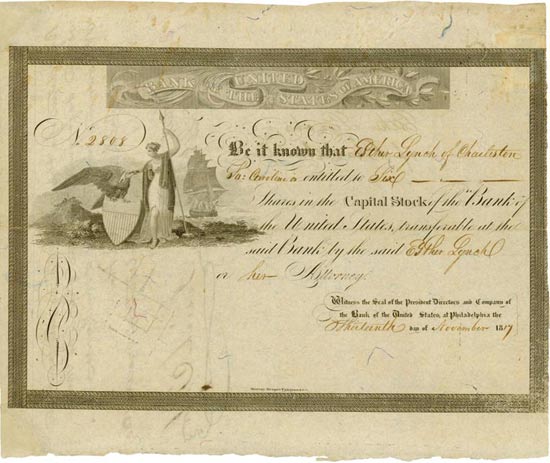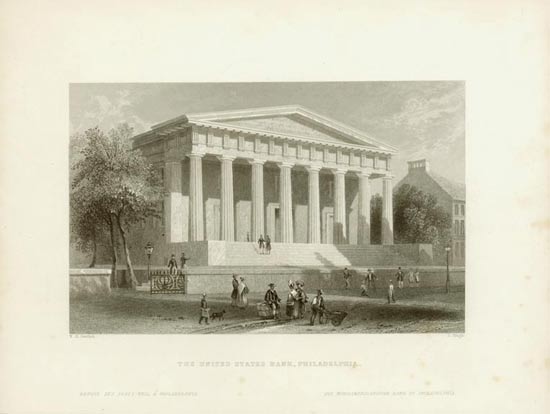Ingelsberg 17 b
D- 85604 Zorneding
Deutschland / Germany
Tel.: +49 (0)8106 - 2461-86
Fax: +49 (0)8106 - 2461-88
E-Mail: auktion@hwph.de
HWPH Historisches Wertpapierhaus AG –
Your expert for historical stocks, bonds
and financial history
|
||||
Item number |
12 | |||
Name |
Bank of the United States | |||
Location(s) |
Philadelphia | |||
Country |
USA | |||
Region |
Amerika | |||
Description |
Philadelphia, 13.11.1817, 6 Shares of Capital Stock, #2808, 20 x 24 cm, schwarz, beige, Rand ungleichmässig, schlitzentwertet, schöne Vignette mit Wappen, Wappentier, Allegorie und Schiff, gedruckt von Murray Draper Fairman & Co (einer der Vorläufer der American Bank Note Company), Erhaltung VF, nicht unterschrieben, aber dennoch voll ausgestellt, da nur ein Siegel der Bank notwendig war. Diese Gründeraktie der zweiten Bank of the United States hat eine andere Aufmachung als die späteren Papiere der Gesellschaft (1820/1830er). Da die Aktionäre ihre Einzahlungen in drei Raten erbrachten und erst dann die Aktie erhielten, ist das vorliegende Papier eines der frühestes Gründerstücke der zweiten Bank of the United States! Mit dabei: Original Abbildung des Bankgebäudes in Philadelphia aus dem Jahr 1830, das 1819 bis 1824 von William Strickland (1787-1854), dem Ingenieur des Chesapeake & Delaware Canal errichtet worden ist. Rarität! | |||
Description (English) |
Philadelphia, 13 November 1817, 6 Shares of Capital Stock, #2808, 20 x 24 cm, black, beige, unequal margins, cut cancelled, nice vignette with coat of arms, bald eagle, allegory and ship, printed at Murray Draper Fairman & Co (one of the predecessors of the American Bank Note Company), Condition VF, not signed but fully issued because only the seal of the Bank was required. This is the founding share of the second Bank of the United States and is of a different design from the more common later shares (1820s/30s). The founding shares were paid for in 3 instalments and the fully-paid certificates like this were not issued until all instalments paid, so this is one of the earliest shares of the Bank. With an original 1830s print of the Bank’s Philadelphia building, built 1819-24 by William Strickland (1787-1854), architect, outstanding exponent of the Greek Revival, and engineer of the Chesapeake & Delaware Canal. Rarity! | |||
Condition |
VF | |||
 |
||||

| ||||
History (German) |
Die erste Bank of the United States wurde 1911 geschlossen. Der Hintergrund war, dass die Staten diese Funktion selbst übernehmen sollten. Dies funktionierte nicht. Daher wurde 1916 die (Second) Bank of the United States gegründet. Ihre Größe erreichte die Bank durch Nicholas Biddle. Er gewann bereits in jungen Jahren Einblick in internationale Wirtschaftsprobleme. Bereits mit 18 Jahren gehörte er einer Delegation an, die im Frankreich Napoleons über finanzpolitische Fragen des Verkaufs des französischen Louisiana an die USA verhandelte. Rund zehn Jahre später war Biddle einer von fünf Direktoren der Bank of the United States. Später wurde er deren Präsident. Biddle stand stets für eine gesunde Notenbankpolitik, wodurch das amerikanische Währungssystem stabilisiert wurde. Sein Gedanke der politischen Neutralität der Notenbank lebt bis vor wenigen Jahren weiter. Da dem damaligen US-Präsidenten Andrew Jackson der Einfluss von Biddle nicht gefiel, setzte Jackson 1836 durch, dass der Kongress die Konzession der Bank als Staatsbank nicht verlängert hat. | |||
History (English) |
The first Bank of the United States was closed in 1811 with the intention that the states would take over its functions. This did not work well and the second Bank was founded in 1816. The growth of the Bank is largely attributed to Nicholas Biddle. He had already attained insight into international economic problems. At the age of 18 he already belonged to a delegation which in Napoleon’s France negotiated the purchase of French Louisiana by the USA. Around ten years later, Biddle was one of the five government directors of the second Bank of the United States. Later he became its president. Biddle always stood for a healthy central bank policy, whereby the American monetary system was stabilized. His idea of the central bank’s political neutrality lived until a few years ago. The US President Andrew Jackson did not like the influence Biddle had. This was the reason why the Congress in 1836 did not extend the licence of the bank as a national bank. | |||
Please have a look at our highlight items: |
||||













